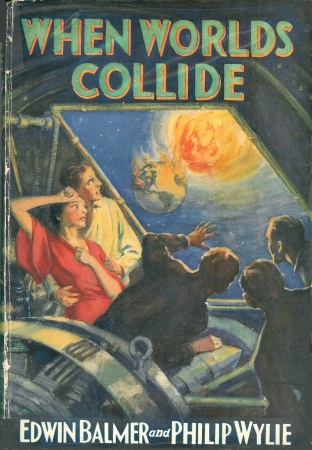Radium-Age Apocalypses
By:
March 13, 2010
A second Hollywood adaptation of When Worlds Collide is in active development. Ho-hum. Trust Hollywood to repeat itself endlessly when there are dozens of other Radium Age apocalypses (War! Plague! Peak Oil! Aliens!) from which directors might pick and choose. Here, in no particular order, are ten of my favorite Radium Age apocalypses.
[A version of this item first appeared on Gawker’s sci-fi blog io9.com, on November 29, 2008.]
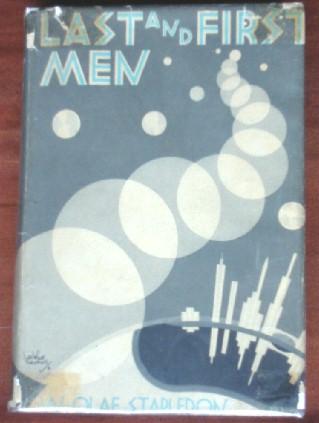
JOSH GLENN’S *BEST ADVENTURES* LISTS: BEST 250 ADVENTURES OF THE 20TH CENTURY | 100 BEST OUGHTS ADVENTURES | 100 BEST RADIUM AGE (PROTO-)SCI-FI ADVENTURES | 100 BEST TEENS ADVENTURES | 100 BEST TWENTIES ADVENTURES | 100 BEST THIRTIES ADVENTURES | 75 BEST GOLDEN AGE SCI-FI ADVENTURES | 100 BEST FORTIES ADVENTURES | 100 BEST FIFTIES ADVENTURES | 100 BEST SIXTIES ADVENTURES | 75 BEST NEW WAVE SCI FI ADVENTURES | 100 BEST SEVENTIES ADVENTURES | 100 BEST EIGHTIES ADVENTURES | 75 BEST DIAMOND AGE SCI-FI ADVENTURES | 100 BEST NINETIES ADVENTURES (in progress) | 1994 | 1995 | 1996 | 1997 | 1998 | 1999 | 2000 | 2001 | 2002 | 2003 | NOTES ON 21st-CENTURY ADVENTURES.
1. MULTIPLE APOCALYPSES, in Olaf Stapledon’s Last and First Men: A Story of the Near and Far Future (1930). In his awe-inspiring, tragicomic first novel, Stapledon, a British philosopher, ventriloquizes the future history of humankind as related to him telepathically by one of the Last Men — alien descendants of ours who will inhabit Neptune, where they’ll face extinction as the sun burns out, some two billion years hence. What does fate hold in store for us First Men? The post-WWI “passionate will for peace and a united world” won’t last long, Stapledon’s narrator informs us. Within a century aerial bombs and poison gas will have laid waste to Europe and Russia, leaving the Chinese and Americans to compete for global military-economic domination. Eventually, a World State will be founded, and peace and prosperity will reign… until Earth’s natural energy sources get used up! At that point, civilization will collapse and the First Men will devolve into superstitious savages living in the shadow of their ancestors’ skyscrapers — “though for the most part they were of course by now little more than pyramids of debris overgrown with grass and brushwood” — until, after nearly 100,000 years, they’ll re-civilize themselves and discover atomic energy. “After a bout of insane monkeying with the machinery,” all but 35 men and women, whose mutated descendants will be the Second Men, are annihilated. This sort of thing goes on, and on, for 18 generations of humankind! One of the most important works of Radium Age science fiction.
FULL TEXT | FIND A COPY
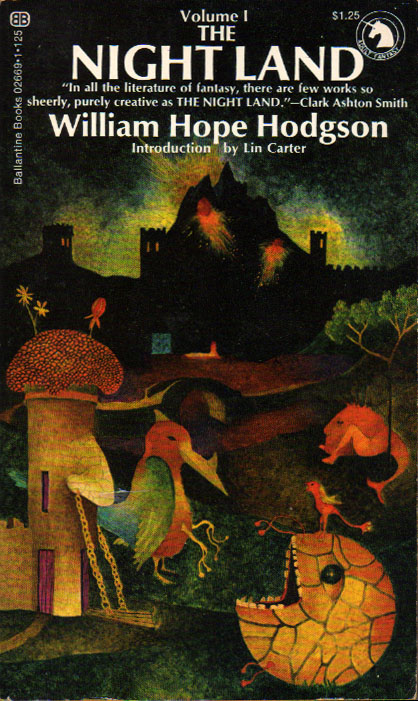
2. TECTONIC SHIFTS & INTER-DIMENSIONAL INVASION, in William Hope Hodgson’s The Night Land: A Love Tale (1912). Hodgson, a British sailor and strongman, paints a macabre portrait — dictated from the future, in a portentously archaic style — of a frozen future Earth whose few remaining human inhabitants live in a vast underground space created by earthquakes, lit by the glare of lava bubbling up from below, and inhabited by dinosaurs. Worse, at some point in the distant past, overreaching scientists breached “the Barrier of Life” that separated our dimension from one populated by “monstrosities and Forces” — Watching Things, Silent Ones, Hounds, Giants, “Ab-humans,” Brutes, enormous slugs and spiders — collectively known as the Slayers. (At least one of them, as far as I can tell from the 1972 Ballantine paperback cover shown here, resembles Pac-Man.) The unnamed narrator, along with apparently every other surviving human, lives trapped in the Last Redoubt, a eight-mile-high metal pyramid-city constructed by their ancestors using now-forgotten technologies. The pyramid is protected from the Slayers, who surround and observe it constantly, by mysterious Powers of Goodness, and also by a massive force-field powered by the “Earth Current” — a Tesla-esque force drawn from the planet itself. Our hero is telepathic, and one day he receives a distress signal that appears to issue from a woman living in a long-forgotten community of humans sequestered in a distant Lesser Pyramid whose power supply is running out. Arming himself with a lightsaber-meets-brushcutter gizmo called a Diskos, and eating nothing but protein pills and powdered water, he sets forth on a mission impossible. The Night Land helps remind us that Lovecraft’s novels — in which humanity is surrounded by all-powerful entities who either don’t care about us or want to destroy us — aren’t fantasy, but Radium Age science fiction.
FULL TEXT | FIND A COPY
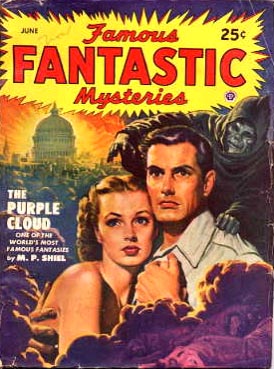
3. CHTHONIC PLAGUE, in M.P. Shiel’s The Purple Cloud (1901). When Brian Aldiss quipped, in reference to Radium Age SF, that “the period was a welter of variously colored plagues,” this is one of the catastrophes he must have had in mind. Not a pandemic but a deadly vapor that sweeps across the planet — perhaps, it’s suggested, as some kind of chthonic punishment (as in M. Night Shyamalan’s The Happening) for humanity’s failure to respect Nature’s mysteries — the purple cloud leaves behind only one living human, Adam Jefferson, who’d been away in the Arctic. Sporting an Englishman’s idea of a Turkish pasha’s get-up (not shown, for some reason, on the cover of the June ’49 issue of Famous Fantastic Mysteries), Adam roams the world in search of other survivors, builds himself a tropical-island castle that would have made Mad King Ludwig jealous, speculates on the nature of the Earth itself (is it intelligent? out to get him?), and burns down cities for fun. The writing is as gorgeously purple as the poison cloud itself: “For oftentimes, both waking and in nightmare, I did not know on which orb I was, nor in which age, but felt my being adrift in the great gulf of space and eternity and circumstance, with no bottom for my consciousness to stand upon, the world all mirage and a strange show to me, and the frontiers of dream and waking lost.” (This is how reading the best Radium Age SF makes you feel, in my experience.) Adam eventually discovers his Eve… but refuses to mate with her, because the human race doesn’t deserve a second chance. Will he change his mind? Fun facts: Shiel was an Englishman born and raised in Barbados, an anti-Semite and racist (he coined the phrase “Yellow Peril”), and — according to some critics — a fascist. Ironically, this novel was an inspiration for the anti-racist SF movie, The World, the Flesh, and the Devil, in which Harry Belafonte refuses to mate with the world’s last woman… because she’s white.
FULL TEXT | BISON EDITION | FIND A COPY
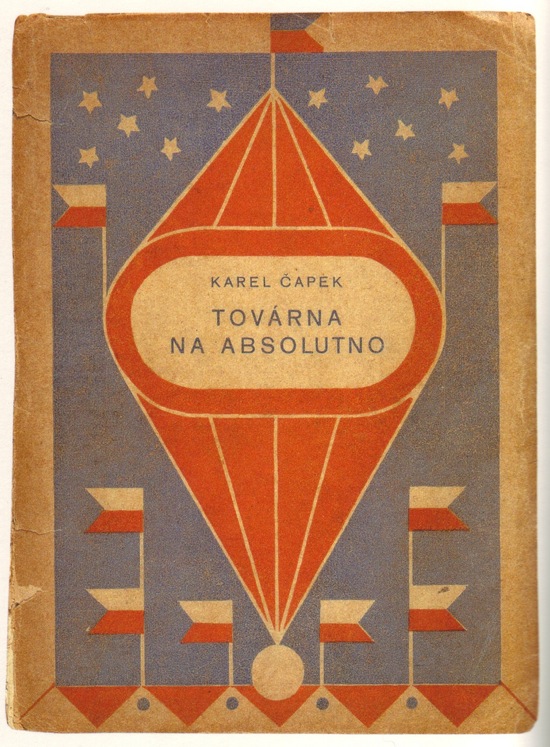
4. CAPITALISM/RELIGION, in Karel Čapek’s The Absolute at Large (1922 as Továrna na absolutno; in English in 1927). In the near future (the Thirties), a Czech scientist invents “perfect combustion,” and an industrial concern starts manufacturing an atomic reactor that provides cheap energy — with an unexpected byproduct: God. To be precise, it’s the Absolute, the spiritual essence that permeates every particle of matter… or did, anyway, until matter began to be annihilated by the super-efficient Karburetor. Instrumental rationality, and the capitalist cult of efficiency, are satirized brilliantly by Čapek, the Czech absurdist whose 1921 play R.U.R. first gave us the word “robot.” As they’re released from imprisoning matter by the Karburetors and Molecular Disintegration Dynamos cranked out in the thousands by Ford Motors (the novel’s Czech title means “the factory of the Absolute”) and other manufacturers around the world, God-particles infect humankind with wonder-working powers and ecstatic religious sentiments. What’s more, the Absolute begins operating factories itself, producing far too many finished goods for anyone to consume: “It wove, spun, knitted, forged, cast, erected, sewed, planed, cut, dug, burned, printed, bleached, refined, cooked, filtered, and pressed for twenty-four to twenty-six hours a day.” As a result, economies collapse, unemployment is universal, and from 1944 through 1953, fanatical sects whose -isms (including rationalism, nationalism, and sentimentalism) are religious only in the broadest sense do battle. Every single country on the planet is drawn into the Greatest War, during which everyone invades everyone else, atomic weapons are deployed, and civilization collapses. Now, that’s instrumental rationality operating at peak efficiency.
FULL TEXT (CZECH) | BISON EDITION | FIND A COPY
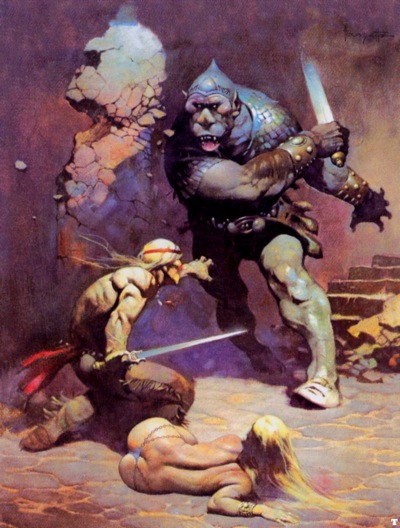
5. COMMUNIST ALIENS, in Edgar Rice Burroughs’ The Moon Maid (1926). Those of us who grew up reading more recent apocalypses like Lucifer’s Hammer, say, might find the preceding four titles — though enjoyable — a tad slow-moving. Perhaps that’s because they weren’t written by Americans, or serialized in American pulps? Not to worry! Burroughs’ The Moon Maid is a multi-generational, three-books-in-one saga that literally gallops from Julian 5th’s crash-landing on the moon, where he makes a daring getaway (with a moon maid in tow) from subhuman Kalkars who dwell in the asteroid’s hollow interior; to the same Julian’s doomed effort to defeat a Kalkar invasion of Earth; to Julian 9th’s failed but inspiring rebellion against the mongrel descendants of the Moon Men, who’ve presided over the Earthlings’ return to a medieval agrarian lifestyle; to the final triumph of Red Hawk (Julian 20th), the leader of a primitive tribe of freedom-fighters who, 400 years after the invasion, finally defeats humankind’s overlords in the ruins of Los Angeles. The Julian 9th story, one hears, was originally written after the Bolshevik revolution, and was rejiggered later to fit into the Moon Maid saga: it’s a red-blooded example of anticommunist SF that predates Ayn Rand’s We the Living and Orwell’s Animal Farm by decades. (“We would slay all the Kalkars in the world, and we would sell the land again that men might have pride of ownership and an incentive to labor hard and develop it for their children, for well we knew by long experience that no man will develop land that reverts to the government at death, or that government may take away from him at any moment.”) No matter what you may think of its politics, The Moon Maid has been described as “Burroughs’ masterpiece of science fiction and a too-often overlooked pioneer work of social extrapolation in science fiction” — which is very true.
MOON MAID – FULL TEXT | MOON MEN – FULL TEXT | RED HAWK – FULL TEXT | BISON EDITION | FIND A COPY
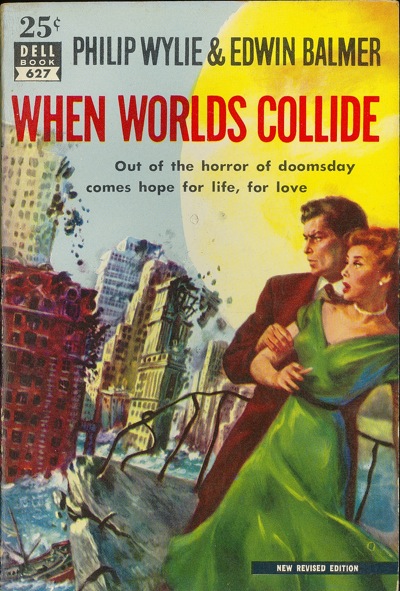
6. ROGUE PLANET, in Philip Gordon Wylie & Edwin Balmer’s When Worlds Collide (1933). Wylie and Balmer’s masterpiece details the efforts of The League of the Last Days — an international band of 1,000 brilliant scientists, action heroes, and fertile women (I exaggerate, but not much; the main female character is named Eve!), who’ve discovered that two rogue planets are entering the sun’s orbit, and that while one of these planets (Bronson Alpha) will collide with the Earth, a remnant of humankind might be able to survive on the other (Bronson Beta) — to design, construct, and outfit rocket-arks that will transport a few of their number to safety. We are treated to two terrifying apocalyptic scenes: One, when the rogue planets first pass by the Earth, triggering stupendous cataclysms; and the other, when worlds collide: “The very Earth bulged… It became plastic. It was drawn out egg-shaped. The cracks girdled the globe. A great section of the Earth itself lifted up and peeled away….” But it’s the post-apocalyptic scenes that are the most haunting: a deserted, Ballardian Chicago whose skyscrapers are knocked out of plumb; violent, half-naked mobs battling the National Guard in Pittsburgh; an army of hate-filled Midwesterners that nearly succeeds in wrecking the rocket-ship project. I also dig the quasi-Nietzschean philosophizing: “What are morals, fundamentally, Tony?” demands Eve of the novel’s protagonist, her fiancé. “Morals are nothing but the code of conduct required of an individual in the best interests of the group of which he’s a member. So what’s ‘moral’ here wouldn’t be moral at all on Bronson Beta.” Eve is explaining, you see, why she won’t be faithful to Tony even if they do survive doomsday. Ouch! Sequel: After Worlds Collide (1934). Fun facts: The book influenced the strip Flash Gordon, while Siegel & Shuster lifted key ideas from both When Worlds Collide and Wylie’s earlier SF novel, Gladiator when they created Superman. George Pal’s 1951 movie adaptation of Worlds is a sci-fi classic, which inspired the Rocky Horror lyrics “‘But When Worlds Collide,’/Said George Pal to his bride,/’I’m gonna give you some terrible thrills.'”
FIND A COPY

7. POISONOUS ETHER, in Arthur Conan Doyle’s The Poison Belt: Being an account of another adventure of Prof. George E. Challenger, Lord John Roxton, Prof. Summerlee, and Mr. E.D. Malone, the discoverers of “The Lost World” (1913). Doyle’s first Professor Challenger tale, The Lost World, was a romp through a South American jungle crawling with prehistoric monsters and beast-men. Why, critics have wondered, did he follow it with a yarn that takes place almost entirely in a locked room? (That’s Challenger, et al., crowded comically together on the book’s spine.) Challenger discovers that the planet is about to be engulfed in a poisonous belt of “ether” (astrophysicists now prefer the term “dark matter”). Inviting his comrades to his home outside London, where he and his wife have laid up a supply of oxygen canisters, which may or may not save their lives, Challenger tells them: “We are assisting at a tremendous and awful function. It is, in my opinion, the end of the world.” Barricading themselves into his wife’s boudoir, like astronauts strapping themselves into a rocket, the adventurers sit and wait, debating everything from the possibilities of the universe to the “abysses that lie upon either side of our material existence,” to the “ideal scientific mind”; meanwhile, the world goes to rack and ruin. True, Poison Belt is a Wellsian exercise, i.e., not nearly as action-packed as Doyle’s usual output. But unlike other apocalyptic fictions, which model proper action in the face of certain disaster, Doyle’s novella models proper attitude — think of Nevil Shute’s On the Beach (’57), for example. Also, the coda, in which humankind becomes more socialist, less fanatically religious and political, and generally wiser, is sweet; and Challenger’s personal qualities — his scholarly sprezzatura, egotism, and nerves of steel — make him fine company, whether in the jungle or in his wife’s boudoir.
FULL TEXT | BISON EDITION | FIND A COPY

8. PANDEMIC, in Jack London’s The Scarlet Plague (1915; first appeared in magazine form in 1912). Although Mary Shelley and M.P. Shiel beat him to the punch, London’s post-apocalyptic plague novel has proved more influential on subsequent SF apocalypses — from Miller’s A Canticle for Leibowitz (’59) to Hoban’s Riddley Walker (’80), to Mike Judge’s 2006 movie Idiocracy, for example — whether they’re of the pandemic, atomic, or natural-disaster variety. One suspects that Scarlet Plague influenced the Moon Men section of Burroughs’ Moon Maid trilogy, too, since the plot begins in 2073, 60 years after a plague has reduced the world’s population to a few scattered bands of neolithic scavengers. London’s vision, like Burroughs’, seems like an anti-communist one: See what happens when the proletariat take over? Everything gets worse, not better! (London sympathized with the working classes, so maybe he was just pointing out how bestial capitalism has made them.) In the post-apocalyptic social order, women are degraded and beaten: Vesta Van Warden, wife of the richest man in America before the plague, we learn from the ancient James Howard Smith, became the chattel of one of her former servants, a man known only as Chauffeur. Predatory nomads — members of the Chauffeur Tribe — named Hoo-Hoo and Hare-Lip roam among the ruins of San Francisco. And Smith, formerly a professor of literature at UC Berkeley, is reviled by his juniors for being literate: “What I want to know,” Edwin continued, “is why you call crab ‘toothsome delicacy’? Crab is crab, ain’t it? No one I never heard calls it such funny things.” Not one of London’s most rollicking adventures, but fun and provocative.
FULL TEXT | FIND A COPY
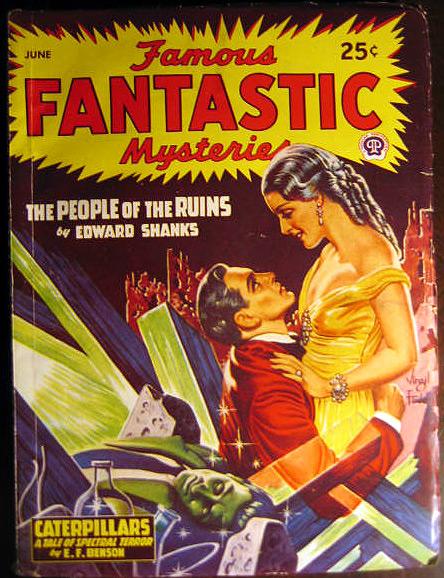
9. WORKER’S REVOLUTION, in Edward Shanks’ People of the Ruins (1920). Like London’s Scarlet Plague, Shanks’ pessimistic postwar novel explores a western society in steep decline. During a workers’ strike in 1924 London, our protagonist — Jeremy Tuft, a physicist — is frozen by an experimental suspended-animation ray (as demonstrated on the cover of the June 1947 issue of Famous Fantastic Mysteries); he wakes up in a medieval-style social order, 150 years hence. Not only have his fellow Englishmen forgotten most of what they used to know, before a worldwide workers’ revolution and famine led to civilization’s collapse, but they don’t particularly care to re-learn any of it. People of the Ruins is, I’d say, an early Sleeper– or Idiocracy-like satire on Edward Bellamy’s Looking Backward or Wells’ The Sleeper Wakes, novels in which a Rip Van Winkle figure finds himself in a wonderful techno-utopia. However, though he is at first disconcerted by the failure of his era’s doctrine of Progress (“He had held the comfortable belief that mankind was advancing in conveniences and the amenities of life by regular and inevitable degrees”), Tuft soon decides that post-civilized life is simpler, more peaceful, safer (“We used to feel that we were living on the edge of a precipice – every man by himself, and all men together, lived in anxiety”). In this sense, then, People of the Ruins is an early example of what Aldiss calls the “cozy catastrophe.” Either way, it’s worth reading — but doesn’t get exciting until the brutish northern English tribes join forces with the Welsh and invade London!
GOOGLE BOOKS
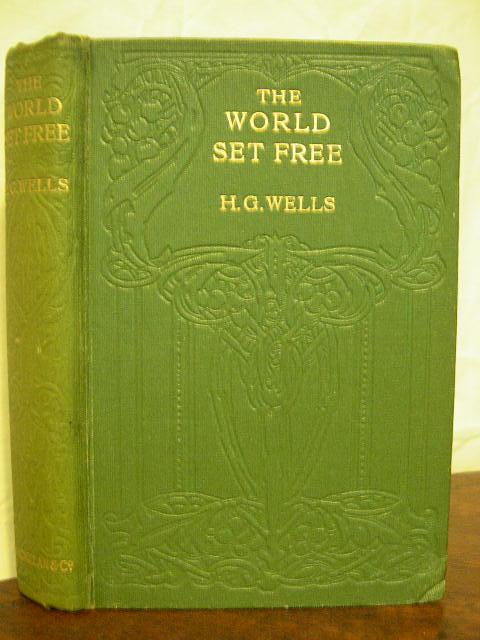
10. ATOMIC WARFARE, in H.G. Wells’ The World Set Free (1914). “It is full of lively ingredients; it has no organic life,” writes Aldiss of this book. “Wells the One-Man Think-Tank has burst into view. His books are no longer novels but gospels.” He’s right. If I’d managed to acquire and read J.D. Beresford’s Goslings (a plague kills every male in London), or Cicely Hamilton’s Theodore Savage (a post-apocalyptic novel by a noted feminist), or John Collier’s Tom’s A-Cold (I like the title), I probably wouldn’t have included this book in this Top Ten list. However, The World Set Free is the best of Wells’ four(!) Radium Age apocalyptic novels, so its lively ingredients are worth a look. Building on the recent discovery that “the atom, that once we thought hard and impenetrable, and indivisible and final and — lifeless — lifeless, is really a reservoir of immense energy,” Wells conjures a 1950s England in which clean, efficient atomic engines have transformed life for the better. Alas, government and education, not to mention social justice, have not kept pace with advances in science and technology, and in the late ’50s a world war breaks out. Atomic bombs that never stop exploding wipe out the world’s great cities. Worldwide civilization is on the brink of collapse — “the community as a whole was aimless, untrained, and unorganized to the pitch of imbecility”; “there were rumors of cannibalism and hysterical fanaticisms in the valleys of the Semoy and the forest region of the eastern Ardennes” — when, rather magically, a New World Order is formed. Fun fact: Hungarian-German-American astrophysicist Leó Szilárd, who worked on the Manhattan Project, claimed that The World Set Free helped him conceive of the nuclear chain reaction.
FULL TEXT | FIND A COPY
ALSO OF INTEREST

THE NINETEEN-OUGHTS (1904-13):
* Gabriel Tarde, Underground Man (1904 as Fragment d’histoire future; 1905 in English)
* George Long, Valhalla: A Novel (1906)
* Van Tassel Sutphen, The Doomsman (1906)
* H.G. Wells, In the Days of the Comet (1906)
* H.G. Wells, The War in the Air (1908)
* James Elroy Flecker, The Last Generation: A Story of the Future (1908)
* J.H. Rosny aîné, La Mort de la Terre [The Death of the Earth] (1910)
* George Barr McCutcheon, Her Weight in Gold (1911; novella: The Wrath of the Dead)
* Henry Darger, In the Realms of the Unreal (1911-39) — a 15,145 page work bound in fifteen immense, densely-typed volumes (with three of them consisting of several hundred illustrations, scroll-like watercolor paintings on paper derived from magazines and coloring books) created over six decades. The majority of the book, The Story of the Vivian Girls, in What is Known as the Realms of the Unreal, of the Glandeco-Angelinian War Storm Caused by the Child Slave Rebellion, follows the adventures of the daughters of Robert Vivian, seven princesses of the Christian nation of Abbieannia who assist a daring rebellion against the evil regime of child slavery imposed by John Manley and the Glandelinians. Children take up arms in their own defense and are often slain in battle or viciously tortured by the Glandelinian overlords. The elaborate mythology includes the setting of a large planet, around which Earth orbits as a moon (where most people are Christian and mostly Catholic), and a species called the “Blengigomeneans” (or Blengins for short), gigantic winged beings with curved horns who occasionally take human or part-human form, even disguising themselves as children.
* Garrett P. Serviss, The Second Deluge (1912)
* Jack London, The Scarlet Plague (1912 in magazine form; 1915 as a book)
* J.D. Beresford, Goslings (1913, pub. in US as A World of Women)
THE TEENS (1914-23):
* George Allan England, Darkness and Dawn (1914)
* Herbert Gubbins, The Elixir of Life, or 2905 A.D.: A Novel of the Far Future (1914)
* Maurice LeBlanc, The Tremendous Event (1920 as Le Formidable Evenement; 1922 in English)
* Cicely Hamilton, Theodore Savage (1922)
* Ella Scrysmour, The Perfect World: A Romance of Strange People and Strange Places (1922)
* C.F. Ramuz, The Triumph of Death (1922 as Presence de la Mort; in English, 1946; pub. in US as The End of All Men)
* J.J. Connington, Nordenholt’s Million (1923)
* P. Anderson Graham, The Collapse of Homo Sapiens (1923)
THE TWENTIES (1924-33):
* H.M. Egbert, Draught of Eternity (1924)
* Martin Hussingtree, Konyetz (1924)
* V.T. Murray, The Rule of the Beasts (1925)
* Edgar Wallace, The Day of Uniting (1926)
* Shaw Desmond, Ragnarok: The Armageddon of the Gods (1926)
* C.E. Jacomb, And A New Earth: A Romance (1926)
* S. Fowler Wright, Deluge: A Romance (1927)
* Charles J. Finger, The Spreading Stain: A Tale for Boys and Men with Boys’ Hearts (1927)
* Pierrepont B. Noyes, The Pallid Giant: A Tale of Yesterday and Tomorrow (1927)
* Philip Francis Nowlan, Armageddon 2419 A.D. (August 1928, novella in Amazing Stories)
* J.W. Chancellor, Through the Visograph (1928)
* Paul Creswick, The Turning Wheel (1928)
* S. Fowler Wright, Dawn (1929)
* Lionel Britton, Brain: A Play of the Whole Earth (1930)
* F. Wright Moxley, Red Snow (1930)
* Thomas Alva Stubbins, The Story of the Tomb of Gold (1932)
* John Collier, Tom’s A-Cold (1933, pub. in US as Full Circle)
* Helen Simpson, The Woman on the Beast: Viewed from Three Angles (1933)
* Neil Bell, The Lord of Life (1933)
* H.G. Wells, The Shape of Things to Come: The Ultimate Revolution (1933)
PLUS:
* Karel Čapek, War with the Newts (1936)
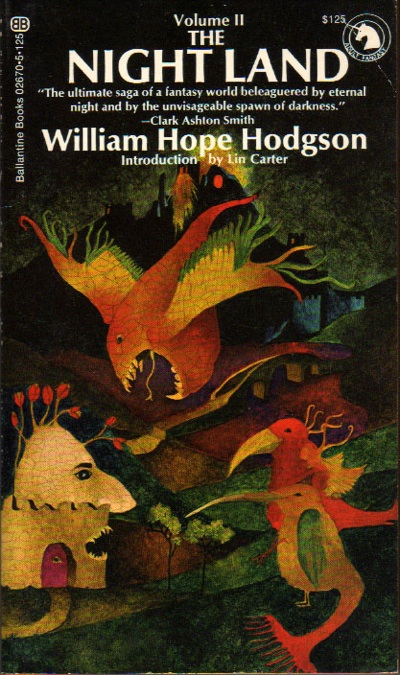
MORE RADIUM AGE SCI FI ON HILOBROW: HiLoBooks homepage! | What is Radium Age science fiction? |Radium Age 100: 100 Best Science Fiction Novels from 1904–33 | Radium Age Supermen | Radium Age Robots | Radium Age Apocalypses | Radium Age Telepaths | Radium Age Eco-Catastrophes | Radium Age Cover Art (1) | SF’s Best Year Ever: 1912 | Radium Age Science Fiction Poetry | Enter Highbrowism | Bathybius! Primordial ooze in Radium Age sf | War and Peace Games (H.G. Wells’s training manuals for supermen) | Radium Age: Context series | J.D. Beresford | Algernon Blackwood | Edgar Rice Burroughs | Karel Čapek | Buster Crabbe | August Derleth | Arthur Conan Doyle | Hugo Gernsback | Charlotte Perkins Gilman | Cicely Hamilton | Hermann Hesse | William Hope Hodgson | Aldous Huxley | Inez Haynes Irwin | Alfred Jarry | Jack Kirby (Radium Age sf’s influence on) | Murray Leinster | Gustave Le Rouge | Gaston Leroux | David Lindsay | Jack London | H.P. Lovecraft | A. Merritt | Maureen O’Sullivan | Sax Rohmer | Paul Scheerbart | Upton Sinclair | Clark Ashton Smith | E.E. “Doc” Smith | Olaf Stapledon | John Taine | H.G. Wells | Jack Williamson | Stanisław Ignacy Witkiewicz | S. Fowler Wright | Philip Gordon Wylie | Yevgeny Zamyatin
READ GORGEOUS PAPERBACKS: HiLoBooks has reissued the following 10 obscure but amazing Radium Age science fiction novels in beautiful print editions: Jack London’s The Scarlet Plague, Rudyard Kipling’s With the Night Mail (and “As Easy as A.B.C.”), Arthur Conan Doyle’s The Poison Belt, H. Rider Haggard’s When the World Shook, Edward Shanks’ The People of the Ruins, William Hope Hodgson’s The Night Land, J.D. Beresford’s Goslings, E.V. Odle’s The Clockwork Man, Cicely Hamilton’s Theodore Savage, and Muriel Jaeger’s The Man with Six Senses. For more information, visit the HiLoBooks homepage.
SERIALIZED BY HILOBOOKS: Jack London’s The Scarlet Plague | Rudyard Kipling’s With the Night Mail (and “As Easy as A.B.C.”) | Arthur Conan Doyle’s The Poison Belt | H. Rider Haggard’s When the World Shook | Edward Shanks’ The People of the Ruins | William Hope Hodgson’s The Night Land | J.D. Beresford’s Goslings | E.V. Odle’s The Clockwork Man | Cicely Hamilton’s Theodore Savage | Muriel Jaeger’s The Man With Six Senses | Jack London’s “The Red One” | Philip Francis Nowlan’s Armageddon 2419 A.D. | Homer Eon Flint’s The Devolutionist | W.E.B. DuBois’s “The Comet” | Edgar Rice Burroughs’s The Moon Men | Charlotte Perkins Gilman’s Herland | Sax Rohmer’s “The Zayat Kiss” | Eimar O’Duffy’s King Goshawk and the Birds | Frances Hodgson Burnett’s The Lost Prince | Morley Roberts’s The Fugitives | Helen MacInnes’s The Unconquerable | Geoffrey Household’s Watcher in the Shadows | William Haggard’s The High Wire | Hammond Innes’s Air Bridge | James Branch Cabell’s Jurgen | John Buchan’s “No Man’s Land” | John Russell’s “The Fourth Man” | E.M. Forster’s “The Machine Stops” | John Buchan’s Huntingtower | Arthur Conan Doyle’s When the World Screamed | Victor Bridges’ A Rogue By Compulsion | Jack London’s The Iron Heel | H. De Vere Stacpoole’s The Man Who Lost Himself | P.G. Wodehouse’s Leave It to Psmith | Richard Connell’s “The Most Dangerous Game” | Houdini and Lovecraft’s “Imprisoned with the Pharaohs” | Arthur Conan Doyle’s “The Sussex Vampire.”
READ MORE essays by Joshua Glenn, originally published in: THE BAFFLER | BOSTON GLOBE IDEAS | BRAINIAC | CABINET | FEED | HERMENAUT | HILOBROW | HILOBROW: GENERATIONS | HILOBROW: RADIUM AGE SCIENCE FICTION | HILOBROW: SHOCKING BLOCKING | THE IDLER | IO9 | N+1 | NEW YORK TIMES BOOK REVIEW | SEMIONAUT | SLATE

